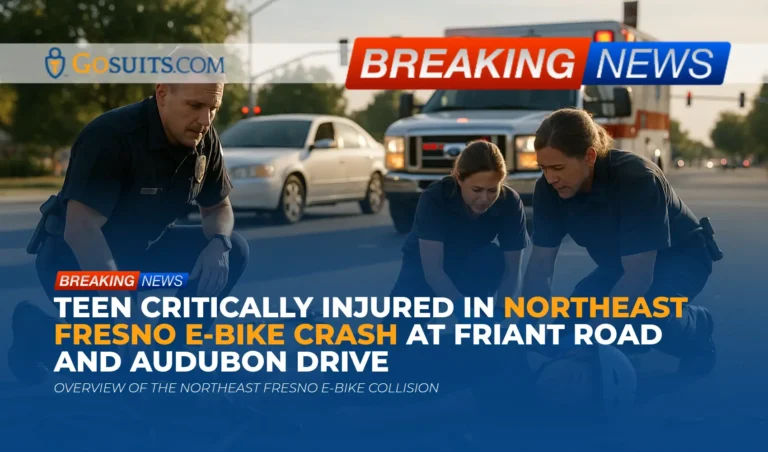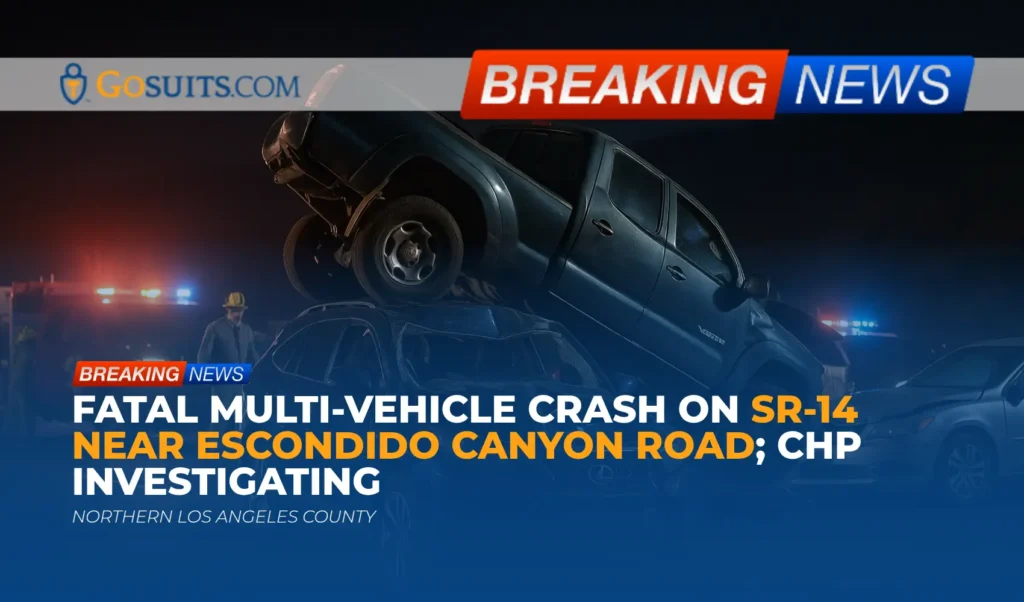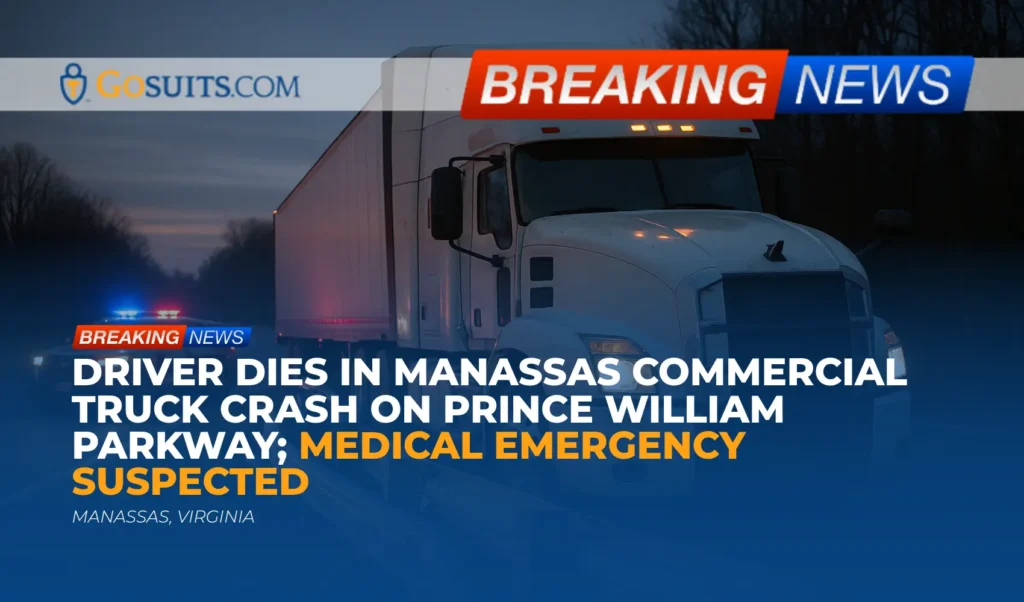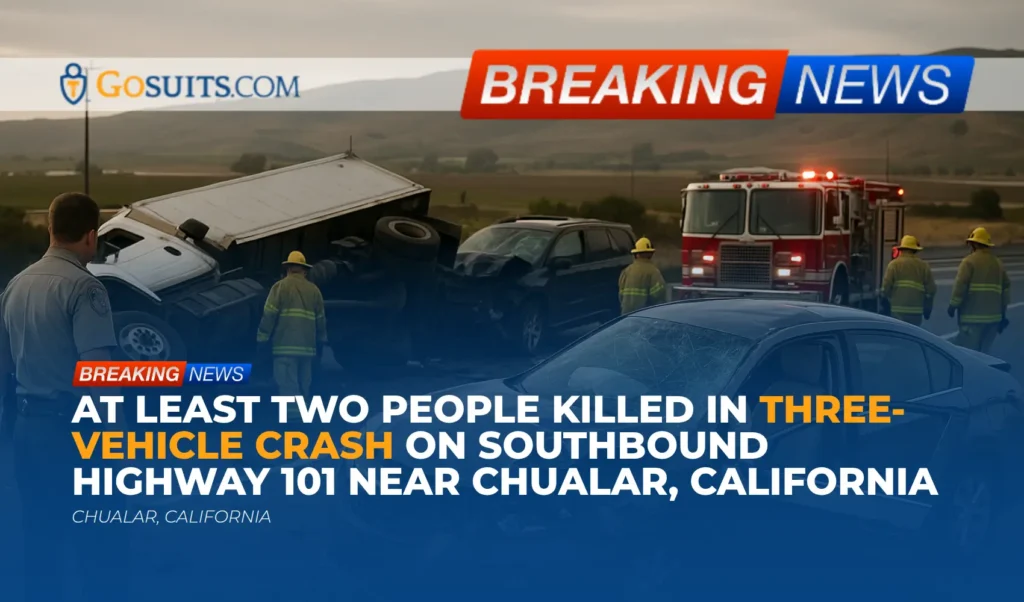- Overview of the Northeast Fresno e-bike collision
- What is known about the crash at Friant Road and Audubon Drive
- Key safety and legal context for e-bikes in California
- Rights after a serious traffic collision in California
- Where to get official records in Fresno County
- Preserving evidence and documenting injuries
- Insurance issues and early mistakes to avoid
- Time limits and special rules that may apply
- Community safety considerations for teens and e-bikes
- Practical next steps
- Why timing and careful action matter
- Commentary from Gosuits Fresno, California Personal Injury Attorney
Overview of the Northeast Fresno e-bike collision
Authorities have reported a serious collision involving a teen riding an e-bike in Northeast Fresno. According to the initial information provided by local news, officers responded to Friant Road and Audubon Drive at approximately 3:00 p.m. on Saturday. A 15-year-old male was located in the roadway and transported to a hospital, where he is reported to be in critical condition. Early accounts indicate the teen was traveling westbound on Audubon Drive with friends, began to swerve, and attempted to cross when a vehicle struck him. The incident remains under investigation.
Our thoughts are with the injured teen, their family, and everyone affected. Early hours following a collision are confusing and difficult. The purpose of this article is to summarize what is publicly known so far, outline available resources, and share general safety and legal context that may help families understand the process that often follows a serious roadway injury.
What is known about the crash at Friant Road and Audubon Drive
Based on the initial report available at the time of writing, these are the key points that have been described:
- Location and time: Friant Road at Audubon Drive in Northeast Fresno, around 3:00 p.m. on Saturday.
- People involved: A 15-year-old male on an e-bike, reportedly riding with friends; at least one motor vehicle.
- Injury status: The teen was taken to the hospital and is in critical condition.
- Preliminary sequence: The teen was traveling west on Audubon Drive toward Friant Road, swerved, and attempted to cross in front of traffic when contact with a vehicle occurred.
- Investigation: Police have stated the crash is under investigation. The final determination about causes and potential contributing factors is not yet available.
These details can change as investigators speak with witnesses, analyze roadway markings, review any video, and possibly reconstruct the collision. Families often do not receive the full report right away; timelines vary depending on the complexity of the investigation.
Key safety and legal context for e-bikes in California
Electric bicycles are increasingly common on Fresno’s streets and trails. California recognizes three classes of e-bikes and sets rules for their operation and safety equipment. The California Department of Motor Vehicles provides an overview of e-bike classifications and helmet requirements. In general:
- Classes of e-bikes: Class 1 and Class 2 are typically limited to 20 mph assistance; Class 3 provides assistance up to 28 mph and has additional restrictions. See the DMV’s bicycle handbook guidance on electric bicycles at dmv.ca.gov.
- Age and helmet rules: Riders under 18 must wear an approved helmet on any bicycle or e-bike. For Class 3 e-bikes, operators must be at least 16 and helmets are required. DMV guidance is available at dmv.ca.gov.
- Roadway rules: In California, bicyclists generally have the same rights and responsibilities as drivers of vehicles when using the roadway. Safety guidance for sharing the road is published by the California Highway Patrol at chp.ca.gov.
At intersections like Friant Road and Audubon Drive, factors such as multi-lane traffic, vehicle speeds, sight lines, and the presence or absence of designated bike facilities can influence risk. Without speculating about this specific crash, common collision scenarios involving teen riders and motor vehicles include turning or crossing movements at busy arterials, limited visibility, and split-second gap judgments. These hazards underscore the importance of well-marked crossings, predictable riding behavior, attentive driving, and speed management by all road users.
National data indicate that injuries involving micromobility devices such as e-bikes and e-scooters have risen in recent years. The U.S. Consumer Product Safety Commission reported continued increases in emergency department visits tied to these devices, reflecting wider adoption and complex traffic environments. See CPSC’s summary at cpsc.gov.
Rights after a serious traffic collision in California
In California, people injured in roadway collisions may be able to pursue civil remedies to address medical costs, lost income, and other legally recognized harms. When a minor is injured, a parent or guardian typically participates in decisions related to medical care, insurance claims, and any potential civil action.
California uses a comparative fault system for civil injury cases. This means that, if more than one party contributed to an incident, responsibility may be allocated among them. The Judicial Council’s civil jury instructions address comparative fault in negligence cases and guide courts and civil juries on how to consider shared responsibility. See the Judicial Council materials at courts.ca.gov.
Fault determinations are based on evidence. Investigators and, later, claims professionals or courts typically examine speed, lane position, traffic controls, right-of-way, visibility, road design, compliance with traffic laws, and potential mechanical issues. A thorough independent investigation can help clarify those questions.
Where to get official records in Fresno County
Official records are essential for understanding what happened. The following agencies and offices are commonly involved in Fresno-area collisions and can be contacted for specific types of records. Availability and timing may vary.
Police collision report
If the Fresno Police Department responded, collision reports are generally maintained by the department’s Records Section. Information about requesting records is available from the City of Fresno’s official police site at fresno.gov. Reports often take several days or longer to finalize. You may need case numbers, dates, and valid identification to request copies, and there are privacy rules about who can access certain information.
California Highway Patrol report
If the California Highway Patrol handled or assisted with the scene, CHP collision reports can be requested following the agency’s procedures described at chp.ca.gov. The CHP page explains who is entitled to a copy and how to submit form requests.
Coroner records
In fatal incidents, the Fresno County Sheriff-Coroner’s Office is responsible for death investigations and related records. Guidance on coroner cases and record requests is provided on the county’s official site at fresnocountyca.gov. This crash, as reported, involves critical injury rather than a fatality. Coroner information is included here for families facing wrongful death situations generally.
Traffic signal timing, roadway design, and public records
In some cases, it is important to understand signal timing, signage, and roadway design features at the location. Requests for public records related to traffic engineering can often be made to the City of Fresno or Fresno County under the California Public Records Act. Information about city departments is posted at fresno.gov, and county departments at fresnocountyca.gov.

Medical records
Medical records are crucial to document injuries, treatment, and prognosis. Federal rules give patients and their personal representatives rights to access medical records. See the U.S. Department of Health and Human Services guidance at hhs.gov. Hospitals and trauma centers will have their own release of information procedures.
Preserving evidence and documenting injuries
Evidence can be lost quickly after a crash. While emergency care comes first, careful documentation in the days that follow often makes a meaningful difference in clarifying what occurred. Consider the following steps, keeping in mind that this is general information and situations differ:
- Photograph the scene and equipment: If safe to do so after the fact, capture photos of the intersection, stop lines, signage, lane markings, lighting, and any visible debris or tire marks. Preserve the e-bike, helmet, and clothing in their post-crash condition.
- Identify witnesses and video: Note names and contact details for anyone who saw the collision. Nearby homes or businesses may have exterior cameras; timing matters for requesting video before it overwrites.
- Maintain medical records: Keep discharge instructions, imaging reports, medication lists, and referrals. Track symptoms over time, including pain levels, dizziness, headaches, or cognitive changes that sometimes evolve after head trauma.
- Track expenses and impacts: Save receipts for medical bills, transportation to appointments, and any adaptive equipment. Document school or activity disruptions for a minor.
- Avoid repairs or alterations: Do not repair the e-bike or helmet until an inspection has been completed by appropriate professionals, in case mechanical analysis becomes important.
Insurance issues and early mistakes to avoid
Insurance can involve multiple policies after a vehicle versus e-bike collision. Auto liability insurance for the driver may be implicated. The rider’s family might also have coverage that could affect medical payments or uninsured motorist issues, depending on policy language. The California Department of Insurance provides consumer-oriented guidance about auto claims and working with insurers at insurance.ca.gov.
Common issues that arise early include:
- Recorded statements: Insurance adjusters sometimes request recorded statements shortly after a crash. Statements can be used later in the claims process. It is prudent to speak with a qualified attorney before providing any recorded statement.
- Social media and public posts: Photos or comments can be misinterpreted and taken out of context.
- Early settlement offers: Initial offers may arrive before the full scope of injuries is known. Particularly with head, spine, or orthopedic trauma, the long-term picture can evolve.
- Policy coordination: Health insurance, medical payments coverage, and any applicable auto coverages each have rules about billing and reimbursement. Missteps can affect out-of-pocket costs later.
If submitting a claim to an insurer is being considered, it is generally wise to consult an attorney first to understand rights and obligations. What is said to an insurance company can be used against the claimant later.
Time limits and special rules that may apply
California law sets deadlines for filing lawsuits and, in some cases, for giving notice to government entities. Missing a deadline can affect the ability to pursue a claim. Two timelines commonly discussed in serious injury matters are:
- General personal injury statute of limitations: In California, the typical deadline to file a lawsuit for personal injury is two years from the date of injury. See California Code of Civil Procedure section 335.1 at leginfo.legislature.ca.gov.
- Claims against public entities: If a public entity is potentially involved, California’s Government Claims Act generally requires a written claim within six months of the incident in many personal injury cases. See Government Code section 911.2 at leginfo.legislature.ca.gov.
When a minor is injured, certain deadlines can work differently. California law includes rules that may toll some statutes of limitations during minority, but special notice requirements for public entities can still apply. The specifics are fact dependent, and families often benefit from tailored guidance about timing. The California Courts’ self-help resources provide general civil information at courts.ca.gov.
Community safety considerations for teens and e-bikes
E-bikes provide mobility and independence but also introduce speed and mass that change the dynamics of common bicycle risks. Parents, schools, and local agencies often work together to improve safety through education, infrastructure, and enforcement. Evidence-based considerations include:
- Helmet use and fit: Properly fitted helmets reduce the risk of serious head injury. Riders under 18 are required to wear helmets in California. Guidance on helmet use is part of state bicycle safety materials at chp.ca.gov and the DMV’s bicycle handbook at dmv.ca.gov.
- Intersection behavior: Many severe crashes occur at intersections. Practicing lane positioning, scanning, and communicating intentions are critical skills. The California Highway Patrol provides safety practices for navigating traffic at chp.ca.gov.
- Visibility: Bright clothing, reflectors, and lights can improve conspicuity. Riders should assume they may not be immediately seen by drivers, especially near multi-lane arterials.
- Speed management: E-bikes can reach speeds faster than many drivers expect from bicycles. Familiarity with braking distances and controlled gap selection at crossings is important for younger riders.
- Data on injuries: The Consumer Product Safety Commission has documented increases in injuries involving micromobility devices like e-bikes and e-scooters in recent years, underscoring the need for local safety strategies. See CPSC’s report summary at cpsc.gov.
Local infrastructure adjustments such as protected crossings, traffic calming, and clear signage near popular teen routes can also reduce risk. Requests for traffic safety reviews may be directed to the City of Fresno’s transportation and public works departments, which are listed at fresno.gov.
Practical next steps
Here are practical, good-faith steps that communities often take after a serious roadway injury, offered in an educational spirit:
- Obtain the official collision report: Confirm which agency responded and request the report when it becomes available. For Fresno Police Department reports, see fresno.gov. If CHP responded, see chp.ca.gov.
- Consolidate medical information: Keep all hospital and follow-up records together and maintain a timeline of treatment. Review rights to access records at hhs.gov.
- Identify and preserve video evidence: Politely inquire with nearby businesses or residents about any footage from the time of the crash, as many systems overwrite within days.
- Consider an independent scene review: Where safe, photograph sight lines, traffic controls, and any obstructions. Note sun angle for the time of day and typical traffic patterns.
- Document communications: Keep copies of correspondence with insurers or agencies. If an insurance company asks for a recorded statement, it is generally wise to consult an attorney before responding.
- Review e-bike equipment: Save the e-bike and protective gear as they were after the incident in case inspection is needed later.
Why timing and careful action matter
There are narrow windows of time when evidence is most accessible. Traffic camera loops can overwrite quickly, businesses routinely purge surveillance footage, and roadway marks fade. Promptly gathering and safeguarding information helps ensure that facts drive outcomes instead of assumptions.
Insurance companies commonly move fast to set the narrative and collect statements. Acting with care before making formal statements can reduce the risk of misunderstandings. Early medical documentation is also critical, since symptoms from head and spine injuries may evolve over days or weeks.
Public entity claims can involve shorter notice deadlines than standard civil claims. If roadway conditions, signage, or signal timing are potentially relevant, it is important to understand whether any public entity is implicated and what notice requirements may apply. The Government Claims Act generally requires written notice within six months for many personal injury claims involving public entities. See California Government Code section 911.2 at leginfo.legislature.ca.gov.
When communicating with any insurance carrier about the incident, it is prudent to consult an attorney first and consider obtaining a free consultation to understand rights and responsibilities. Statements made to insurers can be used later and may shape the claim.

Commentary from Gosuits Fresno, California Personal Injury Attorney
We are thinking of the injured teen, their family, and everyone who witnessed this crash. Serious injuries change lives in an instant, and the uncertainty that follows is incredibly hard. This commentary is offered for educational purposes and general information only.
Collisions at busy arterial intersections like Friant Road and Audubon Drive often involve multiple factors. In our experience, careful analysis looks at visibility, lane geometry, traffic volumes, signal timing, approach speeds, and rider and driver decision windows. For teen riders on e-bikes, the combination of higher attainable speeds and complex multi-lane crossings can compress the margin for error. A thorough, fact based review is important before anyone reaches conclusions about responsibility.
Large insurance companies and corporate defendants have structured processes that begin immediately after a crash. Adjusters are trained to gather statements, shape the theory of what happened, and evaluate claims in ways that may minimize payouts. Families, especially when focusing on medical care, are at an information disadvantage. Without context about comparative fault, injury valuation, and long term medical trajectories, it is easy to feel pressured into early decisions that do not reflect the full picture.
A free consultation with a seasoned injury attorney can help people understand the path forward without committing to any course of action. It can clarify what evidence to prioritize, how to avoid common insurance pitfalls, and which timelines matter most. Even if no claim is ultimately pursued, getting clear, informed guidance early helps families focus on healing while protecting their rights.
Additional official resources referenced in this article
- California DMV Bicycle Handbook and Electric Bicycle rules: dmv.ca.gov
- California Highway Patrol bicycle safety program: chp.ca.gov
- Consumer Product Safety Commission micromobility injury trends: cpsc.gov
- California Department of Insurance auto claims guidance: insurance.ca.gov
- City of Fresno Police Records information: fresno.gov
- CHP collision report information: chp.ca.gov
- Fresno County Sheriff-Coroner: fresnocountyca.gov
- HIPAA medical records access rights: hhs.gov
- California Code of Civil Procedure 335.1 two year personal injury limitation: leginfo.legislature.ca.gov
- California Government Code 911.2 claim deadline for public entities: leginfo.legislature.ca.gov






